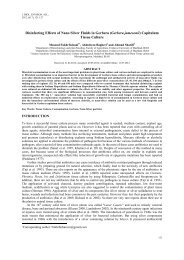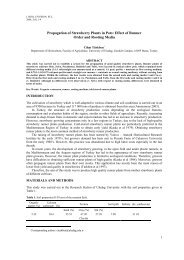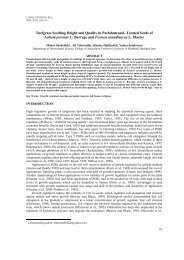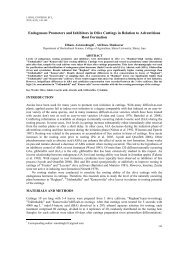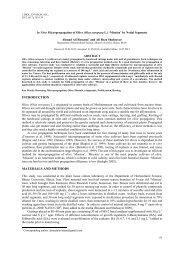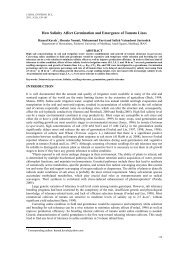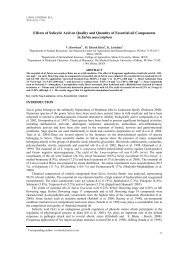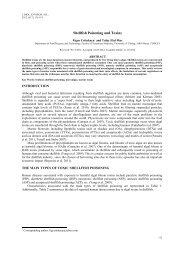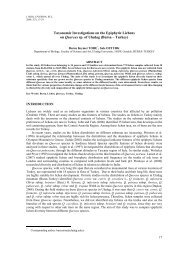The Potential of Corn (Zea mays) for Phytoremediation of Soil ...
The Potential of Corn (Zea mays) for Phytoremediation of Soil ...
The Potential of Corn (Zea mays) for Phytoremediation of Soil ...
You also want an ePaper? Increase the reach of your titles
YUMPU automatically turns print PDFs into web optimized ePapers that Google loves.
J. BIOL. ENVIRON. SCI.,<br />
2011, 5(13), 17-22<br />
Figure 2. Changes <strong>of</strong> Cadmium in <strong>Corn</strong><br />
T1, T2, T3, T4 and T5 are treatments 1, 2, 3, 4 and 5, respectively<br />
R and S are Root and Shoot, respectively<br />
According to Tables 2, It was clear that the concentration <strong>of</strong> Cd significantly decreased in the planted<br />
soil after 60 days culture. Accumulation <strong>of</strong> cadmium in root is higher than in shoot, this showed that root <strong>of</strong><br />
<strong>Corn</strong> is more active than shoot to phytoremediation <strong>of</strong> cadmium. This is in line with finding <strong>of</strong> Zhang et al.<br />
(2009) and Xiao et al. (2008).<br />
Increasing soil contamination to 8 (ppm) increased phytoremediation <strong>of</strong> cadmium from soil by <strong>Corn</strong><br />
but increasing soil contamination to 16 (ppm) decreased phytoremediation <strong>of</strong> cadmium from soil by <strong>Corn</strong>.<br />
<strong>Phytoremediation</strong> <strong>of</strong> Lead<br />
Water soluble and exchangeable lead are the only fractions readily available <strong>for</strong> uptake by plants.<br />
Oxyhydroxides, organic, carbonate, and precipitated <strong>for</strong>ms <strong>of</strong> lead are the most strongly bound to the soil.<br />
<strong>The</strong> capacity <strong>of</strong> the soil to adsorb lead increases with increasing pH, cation exchange capacity (CEC), organic<br />
carbon content, soil/water Eh (redox potential) and phosphate levels. In the natural setting, lead<br />
hyperaccumulation has not been documented. However, certain plants have been identified which have the<br />
potential to uptake lead (Henry 2000).<br />
Table 4. Comparing the means <strong>of</strong> Pb treatments in soil after 60 days<br />
Treatments<br />
Parameter<br />
T1 T6 T7 T8 T9<br />
Pb (ppm) 0.00a + 3.64b 7.23c 10.80d 14.17e<br />
+ Row means followed by the same letter are not significantly different at 0.05 probability level<br />
Figure 3. Changes <strong>of</strong> Lead in soil<br />
T1, T2, T3, T4 and T5 are treatments 1, 6, 7, 8 and 9, respectively<br />
A and B are soils be<strong>for</strong>e 60 days and after 60 days, respectively<br />
20



